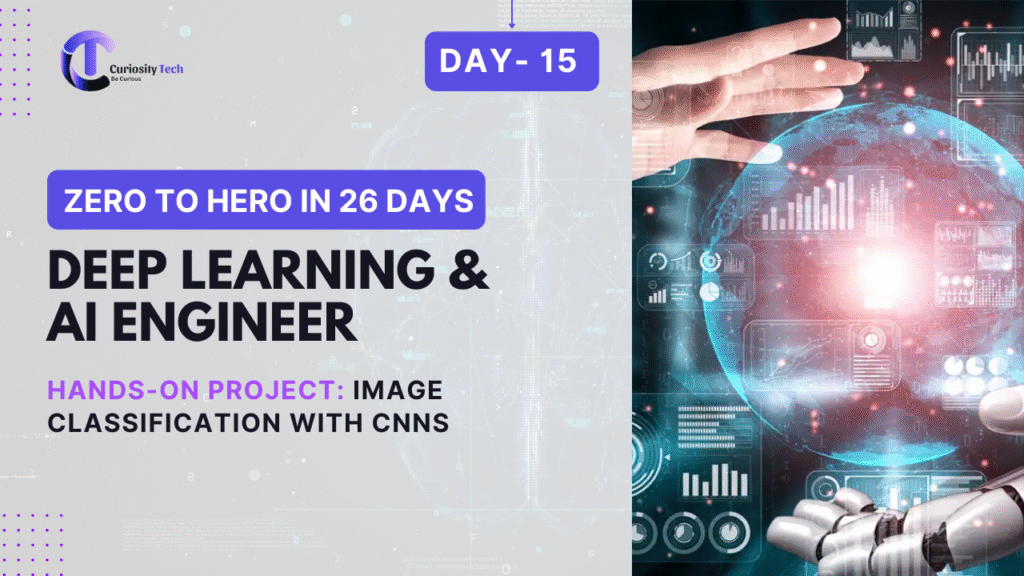Introduction
Image classification is a fundamental task in computer vision and a great way to learn Convolutional Neural Networks (CNNs). CNNs automatically extract features from images, eliminating the need for manual feature engineering.
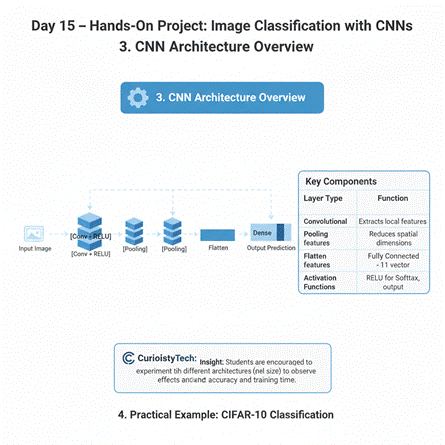
At CuriosityTech.in, learners in Nagpur build end-to-end CNN-based image classifiers, gaining hands-on experience in data preprocessing, model building, evaluation, and deployment, making them industry-ready for computer vision roles.
1. What is Image Classification?
Image classification involves assigning a label to an image based on its content.
Applications:
- Object detection (cars, animals, fruits)
- Medical imaging (disease diagnosis from X-rays or MRIs)
- Industrial inspection (defective product detection)
- Autonomous vehicles (traffic signs recognition)
Core Steps in a CNN Project:
- Data Collection and Preprocessing
- CNN Architecture Design
- Model Training
- Model Evaluation
- Deployment
2. Data Collection and Preprocessing
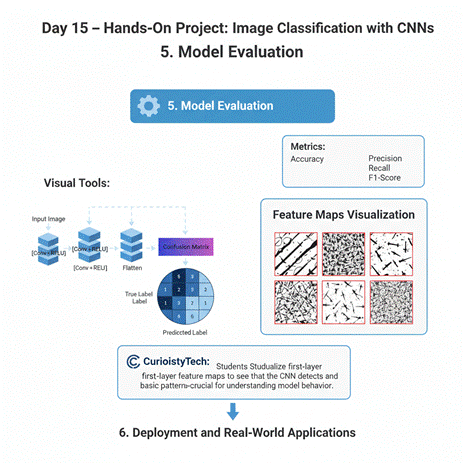
Step 1 – Dataset:
- Popular datasets: CIFAR-10, MNIST, Fashion-MNIST, ImageNet subsets
Step 2 – Preprocessing:
- Resize images to a consistent shape (e.g., 32×32, 224×224)
- Normalize pixel values (0–1 or -1 to 1)
- Apply data augmentation to improve generalization:
- Rotation, flipping, zooming, brightness adjustment
- Rotation, flipping, zooming, brightness adjustment
Step 3 – Split Dataset:
- Training set (70–80%)
- Validation set (10–15%)
- Test set (10–15%)
3. CNN Architecture Overview
Key Components:

| Layer Type | Function |
| Convolutional | Extracts local features from images |
| Pooling (Max/Average) | Reduces spatial dimensions, controls overfitting |
| Flatten | Converts 2D feature maps to 1D vector |
| Fully Connected | Maps features to output classes |
| Activation Functions | ReLU for hidden layers, Softmax for output |
Visual Explanation (Textual Diagram):
Input Image → [Conv + ReLU] → [Pooling] → [Conv + ReLU] → [Pooling] → [Flatten] → [Dense] → Output Prediction
CuriosityTech Insight: Students are encouraged to experiment with different architectures (number of filters, kernel size) to observe effects on accuracy and training time.
4. Practical Example: CIFAR-10 Classification
import tensorflow as tf
from tensorflow.keras.models import Sequential
from tensorflow.keras.layers import Conv2D, MaxPooling2D, Flatten, Dense
from tensorflow.keras.preprocessing.image import ImageDataGenerator
# Data preprocessing
train_datagen = ImageDataGenerator(rescale=1./255, rotation_range=20, horizontal_flip=True)
train_generator = train_datagen.flow_from_directory(‘train_data’, target_size=(32,32), batch_size=32, class_mode=’categorical’)
# CNN Model
model = Sequential([
Conv2D(32, (3,3), activation=’relu’, input_shape=(32,32,3)),
MaxPooling2D(pool_size=(2,2)),
Conv2D(64, (3,3), activation=’relu’),
MaxPooling2D(pool_size=(2,2)),
Flatten(),
Dense(128, activation=’relu’),
Dense(10, activation=’softmax’)
])
model.compile(optimizer=’adam’, loss=’categorical_crossentropy’, metrics=[‘accuracy’])
model.fit(train_generator, epochs=15)
Observation: Learners see progressive improvement in accuracy as the model learns features like edges, textures, and object shapes.
5. Model Evaluation

- Metrics: Accuracy, Precision, Recall, F1-Score
- Visual Tools:
- Confusion Matrix for misclassification analysis
- Feature maps visualization to understand what CNN is learning
- Confusion Matrix for misclassification analysis
CuriosityTech Example: Students visualize first-layer feature maps to see that the CNN detects edges and basic patterns—crucial for understanding model behavior.
6. Deployment and Real-World Applications
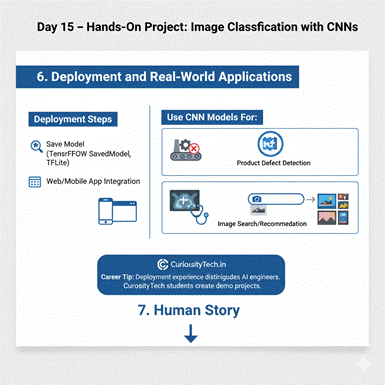
- Save model in TensorFlow SavedModel format or convert to TFLite for mobile deployment
- Integrate into web applications or mobile apps
- Use CNN models for:
- Product defect detection in factories
- Disease detection from medical scans
- Image search and recommendation engines
- Product defect detection in factories
Career Tip: Deployment experience distinguishes AI engineers in the job market. CuriosityTech students create demo projects showcasing real-world use cases.
7. Human Story
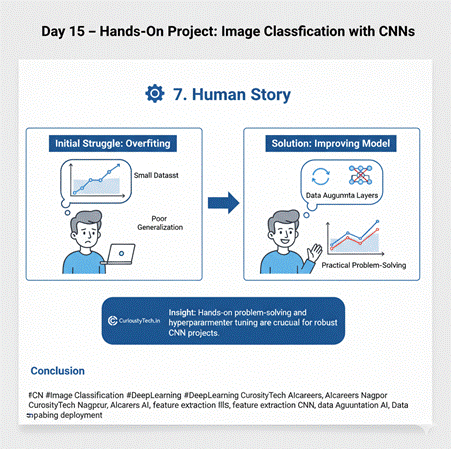
A student initially struggled with overfitting on a small dataset. By applying data augmentation and dropout layers, the model generalized better to unseen images. This experience taught the importance of practical problem-solving and hyperparameter tuning in CNN projects.
Conclusion
Building CNN-based image classifiers teaches learners how to preprocess data, design neural networks, extract features, and deploy models in real-world applications. Platforms like CuriosityTech.in provide hands-on mentorship, project guidance, and portfolio-building opportunities, preparing students to excel in computer vision roles and AI careers.

